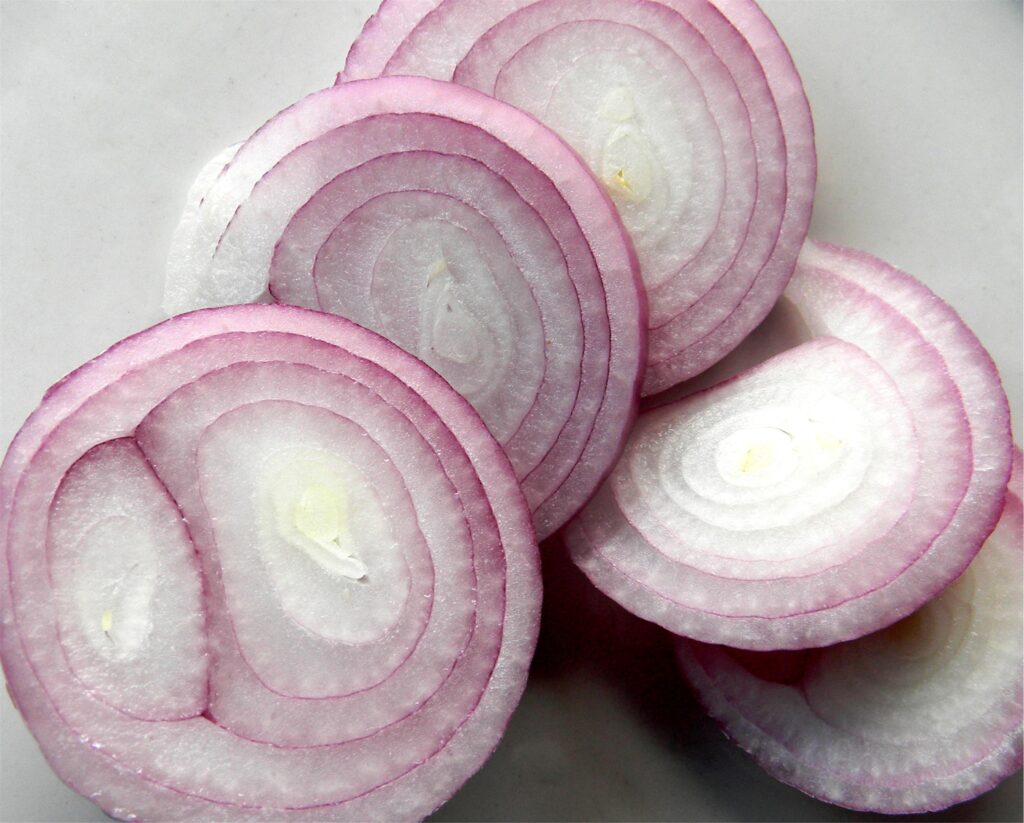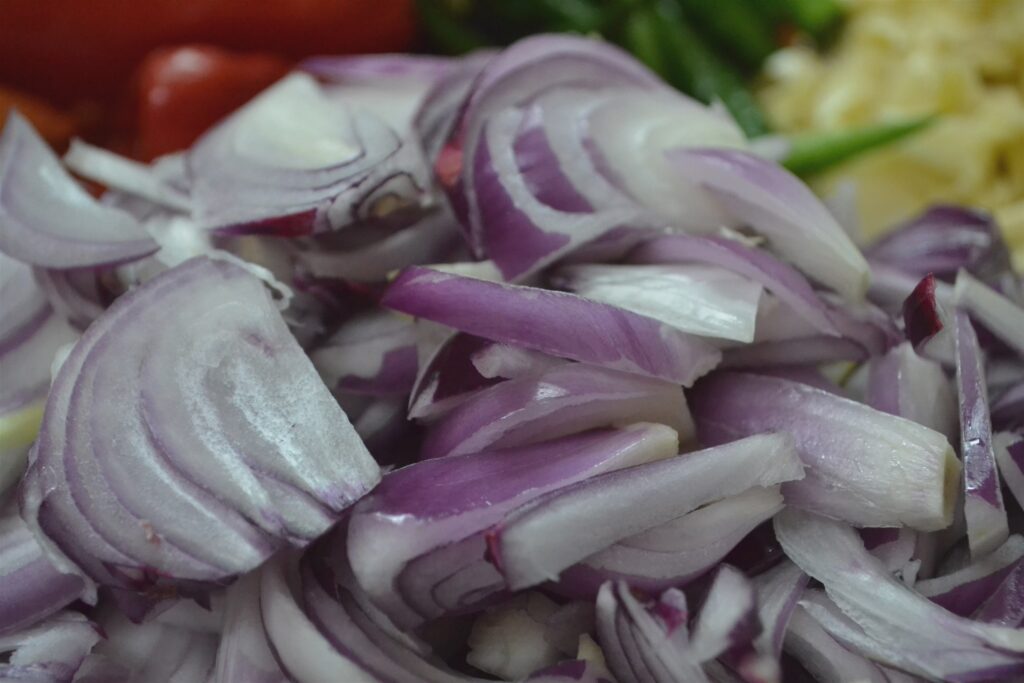Text and Photos by Henrylito D. Tacio
In 1864, General Ulysses S. Grant declared in an advisory to the federal government, “I will not move my army without onions!” Some years later, he became the 18th president of the United States.
“It’s hard to imagine civilization without onions,” said American chef, author, and television personality Julia Child, who brought French cuisine to the American public with her debut cookbook, Mastering the Art of French Cooking.
Onions have been with us since time immemorial. In the olden times, they were mentioned to have been eaten by the Israelites. In Numbers 11:5, the children of Israel lament the meager desert diet enforced by the exodus: “We remember the fish, which we did eat in Egypt freely, the cucumbers and the melons and the leeks and the onions and the garlic.”
Onions have been cultivated for 5000 years or more, according to the National Onion Association in the United States. “Since onions grew wild in various regions, they were probably consumed for thousands of years and domesticated simultaneously all over the world,” it said. “In addition, the onion was useful for sustaining human life. Onions prevented thirst and could be dried and preserved for later consumption when food might be scarce.”
In Egypt, onions can be traced back to 3500 B.C., where they were actually an object of worship. The onion symbolized eternity to the Egyptians who buried onions along with their Pharaohs. The Egyptians saw eternal life in the anatomy of the onion because of its circle-within-a-circle structure. The onion is mentioned as a funeral offering, and onions are depicted on the banquet tables of the great feasts – both large, peeled onions and slender, immature ones. They were shown upon the altars of the gods.
In ancient Greece, athletes ate large quantities of the onion because it was believed that it would lighten the balance of the blood. Roman gladiators were rubbed down with onion to firm up their muscles. During the Middle Ages, onions were such an important food that people would pay for their rent with onions and even give them as gifts.
The Romans, on the other hand, ate onions regularly and carried them on journeys to their provinces in England and Germany. The Roman gourmet Apicius, credited with writing one of the first cookbooks (which dates to the eighth and ninth centuries A.D.), included many references to onions.
Today, onions are available in fresh, frozen, canned, pickled, and dehydrated forms. Onions can be used, usually chopped or sliced, in almost every type of food, including cooked foods and fresh salads, and as a spicy garnish, they are rarely eaten on their own but usually act as an accompaniment to the main course. Depending on the variety, an onion can be sharp, spicy, tangy, and pungent, or mild and sweet.
Onions pickled in vinegar are eaten as a snack. These are often served as a side serving in fish and chip shops throughout the United Kingdom. Onions are a staple food in India and are therefore fundamental to Indian cooking. They are commonly used as a base for curries or made into a paste and eaten as a main course or as a side dish.
“Onions are super-healthy,” said Victoria Jarzabkowski, a nutritionist with the Fitness Institute of Texas at the University of Texas at Austin. “They are excellent sources of vitamin C, sulphuric compounds, flavonoids and phytochemicals.”

“I like to recommend eating onions because they add flavor without salt and sugar,” Jarzabkowski added. Onions are low in calories (45 per serving), very low in sodium, and contain no fat or cholesterol. Furthermore, onions contain fiber and folic acid, a B vitamin that helps the body make healthy new cells.
“The flavonoids in onion tend to be more concentrated in the outer layers of the flesh,” the website of the World’s Healthiest Foods (www.whfoods.com) claims. To maximize its health benefits, “peel off as little of the fleshy, edible portion as possible when removing the onion’s outermost paper layer.” Even a small amount of “overpeeling” can result in unwanted loss of flavonoids.
The total polyphenol content of onions is much higher than many people expect. Polyphenols are one of the largest categories of phytonutrients in food. “The total polyphenol content of onion is not only higher than its fellow allium vegetables, garlic and leeks, but also higher than tomatoes, carrots, and red bell pepper,” the website reports.
The particularly valuable flavonoid in onions is quercetin, which acts as an antioxidant. Although the average onion is likely to contain less than 100 milligrams of quercetin, some onions do provide this amount. “When onions are simmered to make soup, their quercetin does not get degraded,” reports the website. “It simply gets transferred into the water part of the soup. By using a low-heat method for preparing onion soup, you can preserve the health benefits of onion that are associated with this key flavonoid.”
Jo Lewin, a nutritional therapist, suggests that it is better to eat onions in its raw state than cooked. In an article, she wrote: “(Onion) contains a variety of organic sulphur compounds, contained in a volatile oil, that provide the health benefits. These are partly destroyed by heat. When eaten raw, its juice can act as an irritant and some people find it difficult to digest. Those who are not tempted by the idea of eating raw onions can follow simple cooking methods that may make them more palatable.”
Onion has repeatedly been shown to lower our risk of several cancers, even if consumed in only moderate amounts. By “moderate,” experts refer it to “1-2 times per week,” even though in some studies, it has been used to mean up to “5-6 times per week.”
“Colorectal cancer, laryngeal cancer, and ovarian cancer are the cancer types for which risk is reduced along with moderate amounts of dietary onion,” the website of the World’s Healthiest Foods informs. “For other cancer types, however, moderate intake of onion has not been enough to show significant risk reduction. For these cancer types — including esophageal cancer and cancers of the mouth — daily intake of onion is required before research results show significant risk reduction.”
Unknowingly, the chromium in onions assists in regulating blood sugar. Jessie Szalay, a contributor for Live Science, wrote: “The sulfur in onions helps lower blood sugar by triggering increased insulin production. One 2010 study in the journal Environmental Health Insights revealed that this might be especially helpful to people with people with diabetes. People with Type 1 and Type 2 diabetes who ate red onions showed lower glucose levels for up to four hours.”
While eating onions is healthy, there are some precautions that need to be observed. “Eating a large amount of green onions or rapidly increasing your consumption of green onions may interfere with blood thinning drugs,” Szalay reported. He based that information on a study done by the University of Georgia, which found green onions to contain a high amount of vitamin K, which can decrease blood thinner functioning.
Although it is rare, it is possible to have food intolerance or allergy to onions, according to an article in the Journal of Allergy and Clinical Immunology. “People with onion allergies may experience red, itchy eyes and rashes if an onion comes into contact with the skin,” Szalay wrote. “People with intolerance to onions may experience nausea, vomiting and other gastric discomfort.”

By the way, why do you cry when you slice onions? “Slicing onions makes you cry because when you cut into it, the onion produces a sulfur-based gas,” Szalay noted. “The gas reacts with the water in your eyes and forms sulfuric acid. To rid your eyes of this fiery irritant, your tear ducts work overtime. For no more (or fewer) tears, try moving your face farther away from the onion so the gas disperses before reaching your eyes.”

